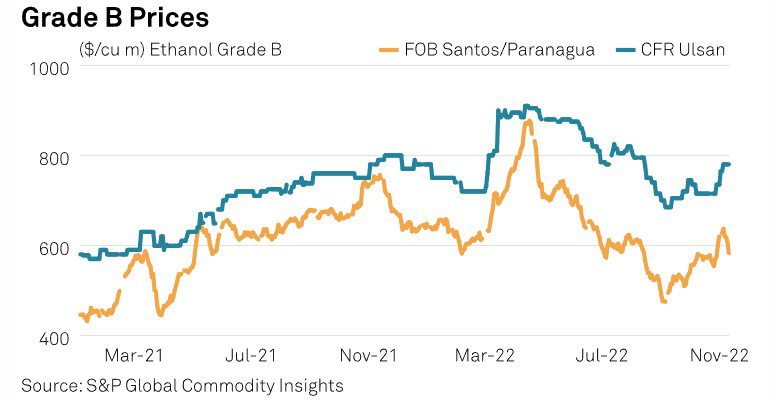The Asian ethanol market is expected to feel the heat from the fight against inflation by its Western counterparts, crimping its post-pandemic recovery and new commitments to boost alternative fuel resources amid fundamental shifts in the energy and agriculture sector from the Russia-Ukraine crisis.
Fuel ethanol demand is expected to pick up as Asia starts to reopen its borders but local buyers anticipated some resistance as nations grapple with economic headwinds.
A Philippines-based trader said: “Schools have resumed full-time, in-person classes since the pandemic began and I believe soon it will be the same for offices. This would mean higher gasoline consumption as activity resumes. However, if global interest rates keep increasing, local demand and spending will drop.”
For 2023, S&P Global Commodity Insights forecast the Philippines’ fuel ethanol consumption at 612 million liters, equating to a 7.9% blending rate.
The US remains the largest exporter of corn-based fuel ethanol. Based on the latest World Agricultural Supply and Demand Estimates report released Dec. 9 by the US Department of Agriculture, US corn use for ethanol in marketing year 2022-23 (September-October) was estimated at 5.275 billion bushes.
The progress of the Russia-Ukraine grain corridor in 2023 would be another key factor impacting Asia’s fuel ethanol import prices. While the Black Sea Grain Initiative was extended by 120 days in November, Russia’s previous attempt to scuttle the deal showed major uncertainty in the agreement and added a huge risk to global grains prices.
Asian Grade B prices dependent on Brazil
Having taken pointers from the struggle to secure supply due to slow responses when high volumes of ethanol was in demand for disinfectants globally during the pandemic, this year Grade B buyers have their entire H1 2023 demand covered. As such, they will be looking for Grade B ethanol from Brazilian sugarcane crop running over the 2023-2024 (April-March) season.
Rains across Brazil’s Central South region in December were causing most mills to end crushing for the 2022-23 season sooner than last year. Therefore, local analysts and traders were expecting cane left in the fields to be harvested earlier next season in March rather than April.
On Dec. 7, Petrobras made its first price adjustment since Sept.1 and reduced gasoline and diesel prices by 6.1% and 8.1%, respectively. Following that, the gap between domestic and international gasoline prices narrowed from 13% on Dec. 9 to 6% on Dec. 16, suggesting room for further reduction and impacting domestic ethanol prices.
Against this backdrop, Asian Grade B prices have been seen trending lower. Platts, assessed Grade B CFR Ulsan at $/cu m on Dec. 16, down $20/cu m week on week, S&P Global Commodity Insights data showed.
“I think the [CFR Ulsan] Grade B price movement in 2023 will be dependent on the size of Brazil’s sugarcane, their gasoline price policy and if the PIS and COFINS federal taxes are reinstated,” a Grade B buyer said.
S&P Global estimated Brazil’s ethanol production from sugar for the 2022-23 crop will be at 28.9 billion liters, while ethanol production for the 2023-24 crop has been forecast higher at 31 billion liters.
Southeast Asia pushes for higher ethanol usage
The effects from the Russia-Ukraine war also prompted Asian countries to roll out plans to diversify its fuel sources. The Indonesian Ministry of Energy and Mineral Resources and the Bandung Institute of Technology Research Team prepared a short-term target to introduce 5% ethanol or E5 mixtures in capital Jakarta and key city Surabaya in the next three years, local media reported Dec. 7.
In its Strategic Roadmap to Accelerate Bioethanol Implementation in Indonesia, there were medium (5 years) and long-term targets. In the medium term, the government aimed to increase bioethanol blending to E10 and expand the bioethanol program to the Java region, where fuel consumption is highest. By 2031, the blend could rise to 15% bioethanol in fuel and distributed nationally.
Additionally, Vietnam aims to develop a green transport system in its push for net-zero emissions by 2050. Under the Decision No. /QD-TTg signed by Deputy Prime Minister Le Van Thanh on July 22, the country planned to have 100% of road vehicles use E5 gasoline by 2030.
“This move will improve the acceptance rate of ethanol in Vietnam as there is no distinction between the different gasoline grades”, a US Grains Council representative said.
India’s ethanol efforts
India also aims to step up fuel ethanol blending beyond 10% in 2023. Other than raising the price of ethanol derived from different sugarcane-based raw materials, the goods and services tax rates on ethanol intended for blending has also been reduced from 18% to 5% on Dec. 17.
In response to the news of the lower GST, Prashanth Tapse, senior vice president of research at Mehta Equities said: “This effort would be a welcome move for the [ethanol] sector growth, and we remain optimistic on the sector for the long term.”
In the automotive sector, India plans to begin a phased introduction of E20 at several gas stations across the country in April 2023.





